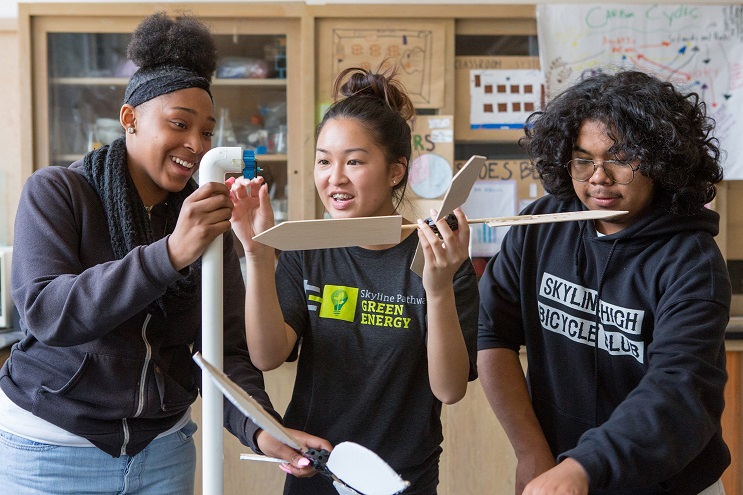The Importance of STEM Education for K-12 Students in Low-Income School Districts
November 27, 2023
In today's rapidly advancing technological world, science, technology, engineering and mathematics (STEM) are at the forefront of innovation and economic growth. While STEM education benefits students across the board, access to quality STEM education is crucial for students in low-income districts to develop the necessary skills and knowledge to thrive in the 21st-century workforce.
Unfortunately, low-income school districts often face significant challenges in providing adequate resources and opportunities for their students. Continue reading to explore the significance of STEM education for K-12 students in low-income communities, its advantages and the steps needed to enhance access to quality STEM programs.
Equalizing Opportunities Through STEM Education
Closing the Achievement Gap
STEM education can bridge the achievement gap between students in low-income school districts and their counterparts in more affluent areas. It provides a pathway for students to acquire highly sought-after skills in the job market, including critical thinking, problem-solving and analytical skills. By equipping students with STEM knowledge, low-income school districts can help level the playing field and empower them to compete on equal footing.
Fostering Innovation and Creativity
STEM education nurtures innovation and creativity among students. It encourages them to think outside the box, explore new ideas and develop inventive solutions to real-world problems. Low-income school districts can inspire students to become future innovators and change-makers in their communities by fostering a culture of curiosity and experimentation.
Opportunities for Higher Education
STEM education can open doors to higher education opportunities for students from low-income backgrounds. Many colleges and universities offer scholarships and programs to support underrepresented students pursuing STEM degrees.
Building Career Pathways

Meeting the Demands of the Job Market
In today's technology-driven society, the demand for STEM professionals is rapidly increasing. According to the U.S. Bureau of Labor Statistics, STEM occupations are projected to grow 8.8% between 2020 and 2030, significantly faster than the average for all occupations. By providing robust STEM education, low-income school districts can prepare students for high-demand careers and equip them with the necessary skills to succeed in the future workforce.
Economic Empowerment
By focusing on STEM subjects, low-income students can break free from the cycle of poverty. A study by the National Science Institute reveals that STEM professionals tend to have higher earning potential than those in non-STEM fields. By investing in STEM education, low-income school districts can increase the likelihood of their students accessing higher education and breaking the cycle of poverty.
Promoting Diversity and Inclusion
Empowering Underrepresented Groups
STEM fields have historically needed more diversity, with underrepresentation of specific demographic groups. By emphasizing STEM education in low-income school districts, educators can empower underrepresented groups, including girls, minority students and those from disadvantaged backgrounds, to pursue STEM careers. Increasing diversity in STEM fields brings fresh perspectives, innovative ideas and promotes a more inclusive society.
Addressing Societal Challenges
STEM education equips students with the tools to tackle complex societal challenges like climate change, healthcare disparities and technological advancements. By nurturing a diverse group of STEM professionals from low-income school districts, we can bring different experiences and perspectives to the table, leading to more comprehensive solutions that address the needs of all communities.
Best Practices to Enhance Access to Quality STEM Education
Incorporating STEM education into low-income schools can be challenging due to limited resources. Still, providing students with equitable access to education and future job opportunities is absolutely possible and essential. Here are some best practices:
Partnerships and Grants
Collaborate with local businesses, colleges and nonprofits interested in promoting STEM education. They might offer your students funding, equipment, volunteers or internship opportunities. You can also apply for local, state and federal grants focused on STEM education.
Teacher Training
Professional development is critical for teachers to feel confident and competent in teaching STEM subjects. Use available resources, such as online training, workshops and conferences. Encourage peer mentoring within the school for teachers to share their experiences and strategies.
The National Math and Science Initiative offers a suite of free classroom-ready STEM lessons and videos. Multiple science, English, math, elementary and AP lessons are available. In addition, TED-Ed, YouTube Teachers, YouTube EDU and TeacherTube provide tools for educators.
Integrate STEM Across the Curriculum
Rather than confining STEM to science or math classes, incorporate STEM principles into humanities, arts and physical education. For example, use statistics in social studies or discuss the physics of movement in a P.E. class. This approach helps students see the relevance of STEM in all aspects of life.
Project-Based Learning
Real-world, hands-on projects can make STEM subjects more engaging and relevant to students. Accomplishing this can be as simple as a local environmental cleanup project, building a simple machine or as complex as coding a website or designing a robot.
After-School and Summer Programs
These programs can provide additional exposure to STEM topics that may not fit into the regular school day. For example, coding clubs, robotics competitions or science fairs.
Mentorship Programs
Connect your students with mentors in STEM fields who can guide them, provide advice, and offer exposure to real-world applications of STEM.
Get the Tools and Resources You Need
Implementing STEM education is about more than having the most advanced resources, but fostering students' curiosity, problem-solving and critical thinking. With creativity and determination, you can provide a quality STEM education regardless of your school's budget.
NMSI offers curriculum supports, coaching and programs to help empower teachers. Our programs help build strong communities of educators who work together, practice together and reflect on their teaching and the needs of their students. The programs and support offered by NMSI are designed to meet educators at the intersections where help is needed to become high-quality teachers who deliver better student outcomes.